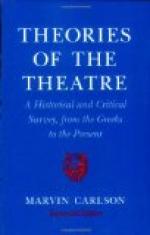Some sense of this must have been in the mind of Sir Henry Irving when he strove industriously to create a dramatist who might survive him and immortalise his memory. The facile, uncreative Wills was granted many chances, and in Charles I lost an opportunity to make a lasting drama. Lord Tennyson came near the mark in Becket; but this play, like those of Wills, has not proved sturdy enough to survive the actor who inspired it. For all his striving, Sir Henry left no dramatist as a monument to his art.
IV
STAGE CONVENTIONS IN MODERN TIMES
I
In 1581 Sir Philip Sidney praised the tragedy of Gorboduc, which he had seen acted by the gentlemen of the Inner Temple, because it was “full of stately speeches and well-sounding phrases.” A few years later the young poet, Christopher Marlowe, promised the audience of his initial tragedy that they should “hear the Scythian Tamburlaine threatening the world with high astounding terms.” These two statements are indicative of the tenor of Elizabethan plays. Gorboduc, to be sure, was a ponderous piece, made according to the pseudo-classical fashion that soon went out of favor; while Tamburlaine the Great was triumphant with the drums and tramplings of romance. The two plays were diametrically opposed in method; but they had this in common: each was full of stately speeches and of high astounding terms.
Nearly a century later, in 1670, John Dryden added to the second part of his Conquest of Granada an epilogue in which he criticised adversely the dramatists of the elder age. Speaking of Ben Jonson and his contemporaries, he said:
But were they now to write, when critics weigh
Each line, and every word, throughout a play,
None of them, no, not Jonson in his height,
Could pass without allowing grains for weight.
* * * * *




